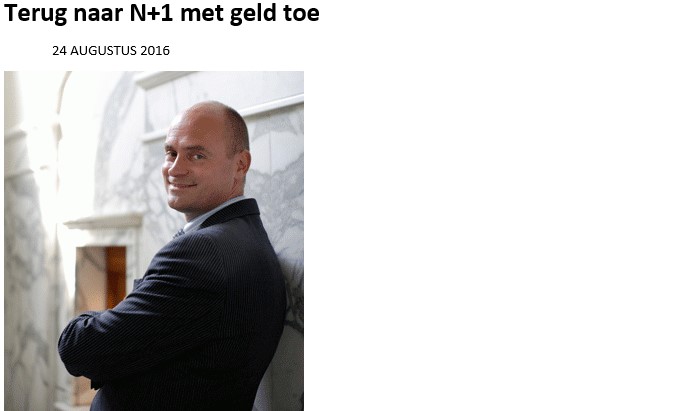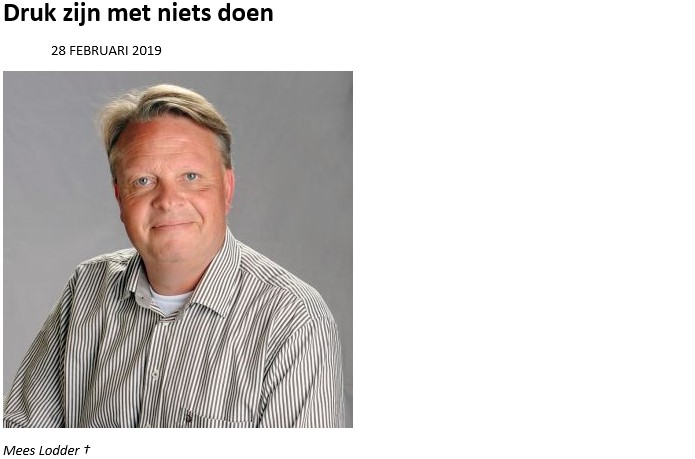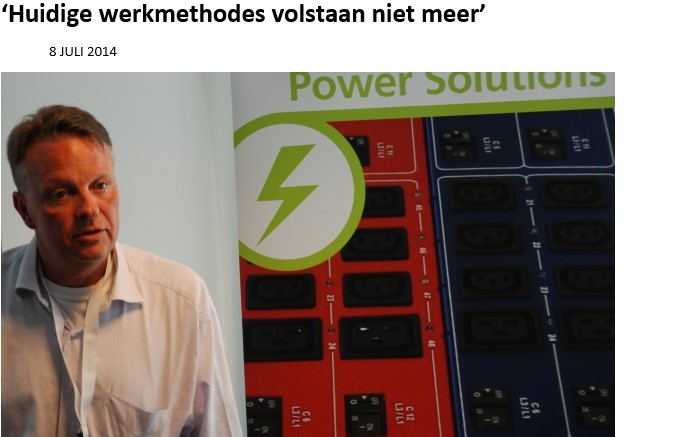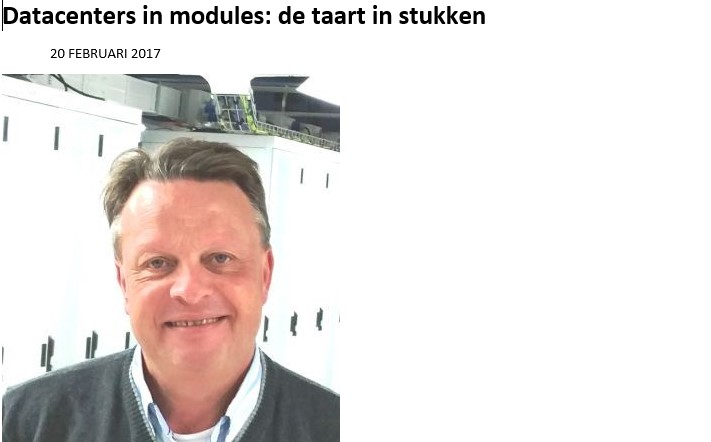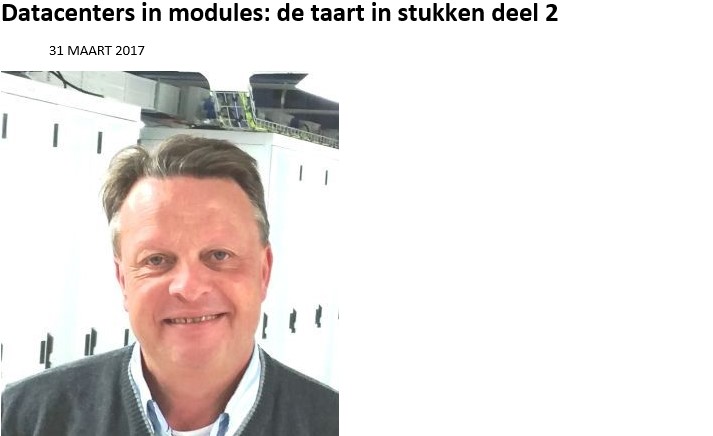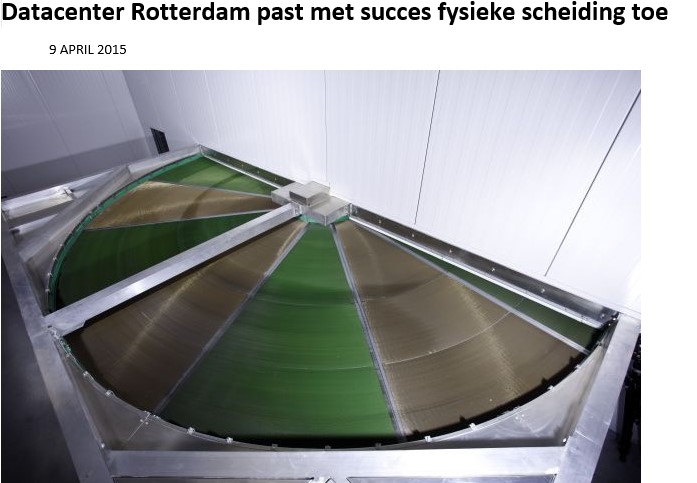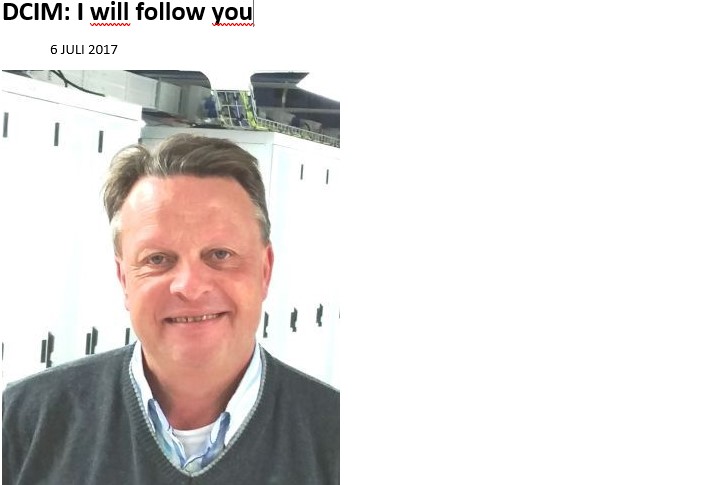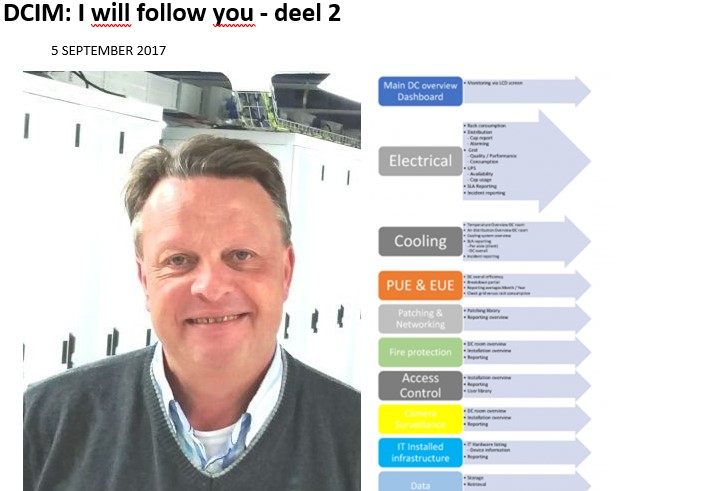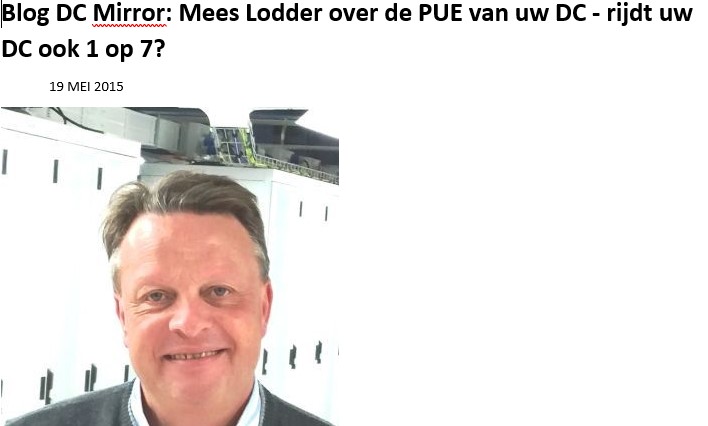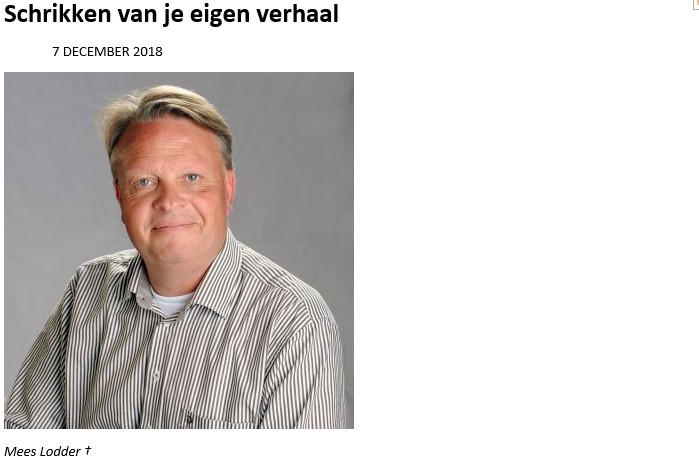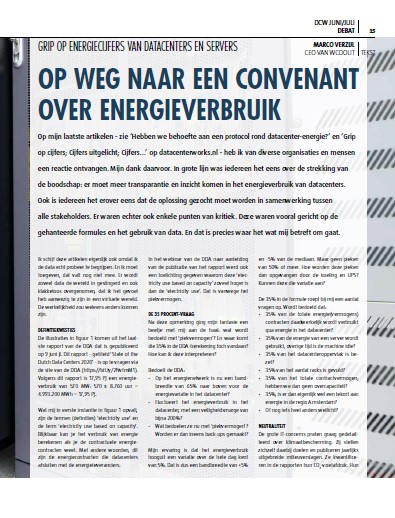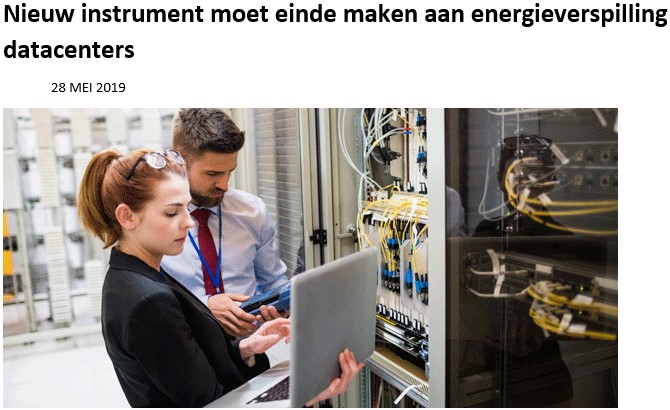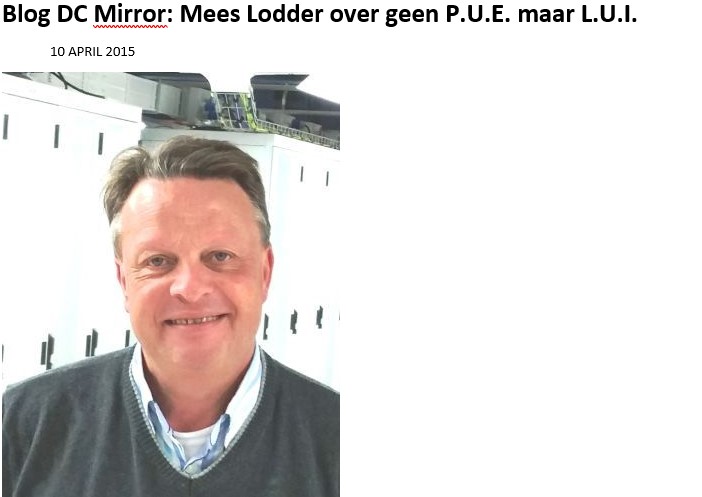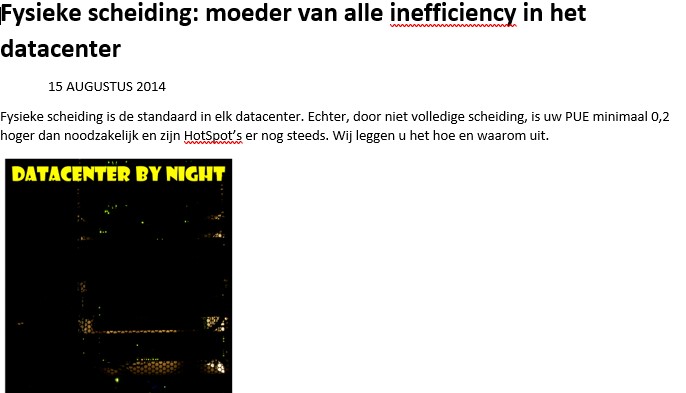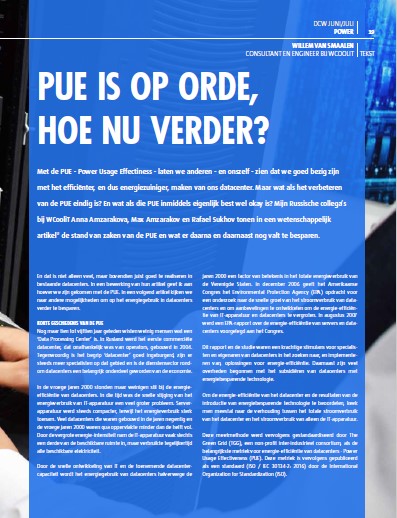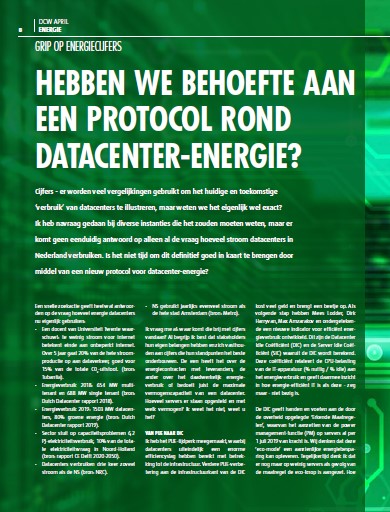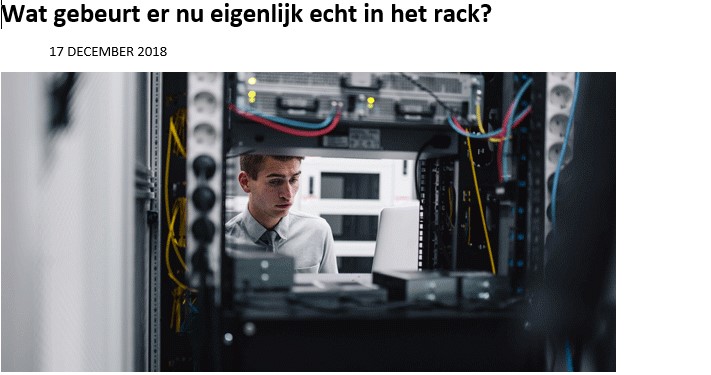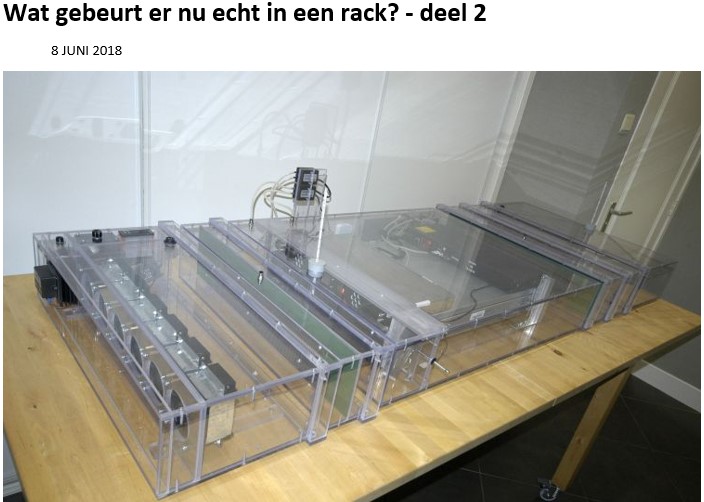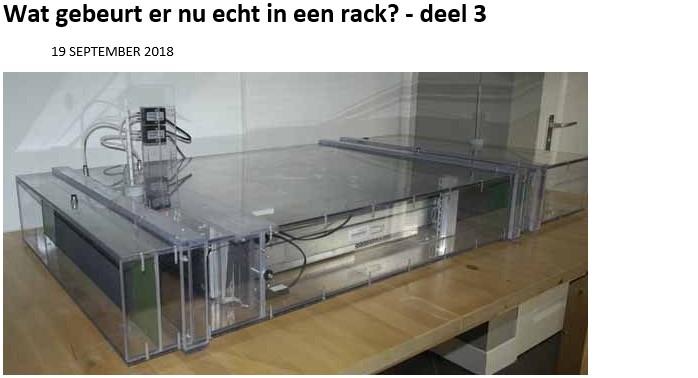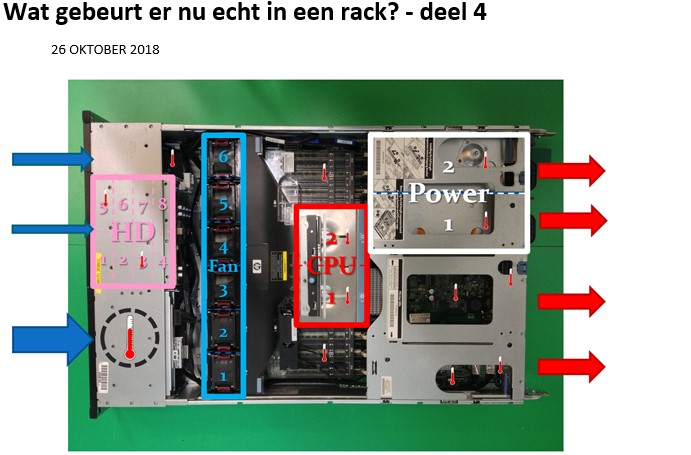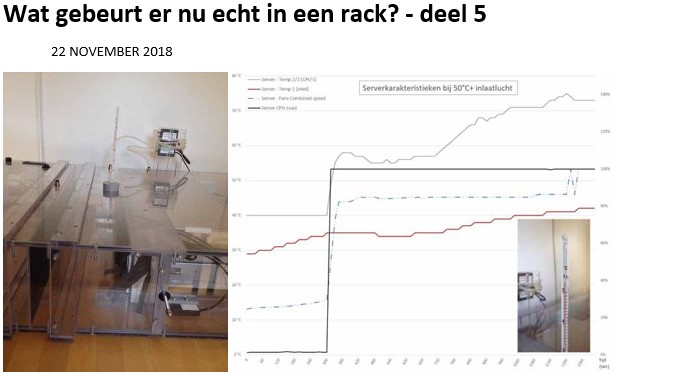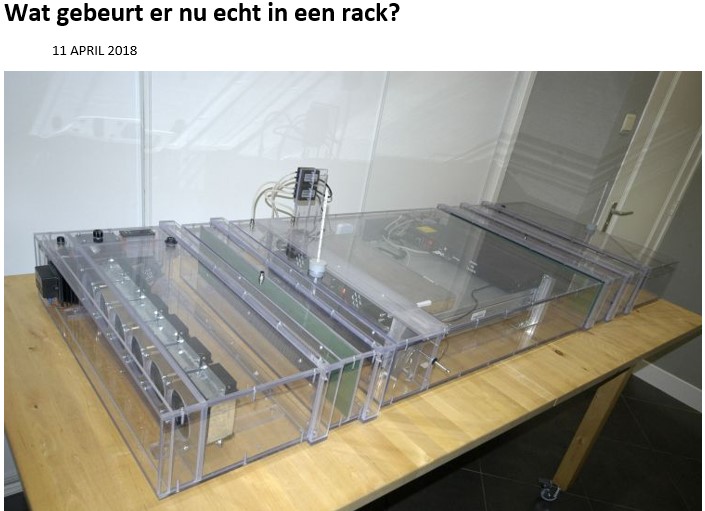2016 AUGUST, DATACENTERWORKS, BOB SEEMANN
Article: Terug naar N+1 met geld toe
N + 1 describes the degree of redundancy. This refers, for example, to the multiple implementation of energy systems and energy supplies in a data center. The ”N” stands for the peak capacity that must be available for day-to-day operations. The figure after the plus sign relates to the number of times that this peak capacity (by means of additional and independently operating installations and power supplies) is additionally available. At N + 1 we always have access to double …
2016 AUGUST, DATACENTERWORKS, BOB SEEMANN
Article: Terug naar N+1 met geld toe
N + 1 describes the degree of redundancy. This refers, for example, to the multiple implementation of energy systems and energy supplies in a data center. The ”N” stands for the peak capacity that must be available for day-to-day operations. The figure after the plus sign relates to the number of times that this peak capacity (by means of additional and independently operating installations and power supplies) is additionally available. At N + 1 we always have access to double …
2019 February, DataCenterWorks, Mees Lodder
Article: Druk zijn met niets doen, only available in Dutch.
Last time I explained why I was so shocked by the ”thermodynamic” efficiency of IT systems. I got to less than 0.1% and the incandescent light just discontinued had 10%.
I also met Harry, an IT specialist, and he could tell me a lot more about it. I have now done that. I’ll keep calling him Harry for convenience. It turned out that he already ”knew” me from KyotoCooling, because he had completely analyzed that for a customer. The conversation went by itself and in short: I think I have found my IT ”soul mate”.
My story to you should therefore also be seen as our story…..
2019 February, DataCenterWorks, Mees Lodder
Article: Druk zijn met niets doen, only available in Dutch.
Last time I explained why I was so shocked by the ”thermodynamic” efficiency of IT systems. I got to less than 0.1% and the incandescent light just discontinued had 10%.
I also met Harry, an IT specialist, and he could tell me a lot more about it. I have now done that. I’ll keep calling him Harry for convenience. It turned out that he already ”knew” me from KyotoCooling, because he had completely analyzed that for a customer. The conversation went by itself and in short: I think I have found my IT ”soul mate”.
My story to you should therefore also be seen as our story…..
2014 JULY, DATACENTERWORKS, MEES LODDER
Article: Huidige werkmethodes volstaan niet meer , only available in Dutch
Raritan recently organized an afternoon about trends in the data center in collaboration with Electronics & Telematics and Dupaco. About twenty-five participants discussed topics such as energy consumption, capacity and PUE, the benefits of physical separation, on-site power generation for data centers and the business side of DCIM. Mees Lodder presented physicall separation
2014 JULY, DATACENTERWORKS, MEES LODDER
Article: Huidige werkmethodes volstaan niet meer , only available in Dutch
Raritan recently organized an afternoon about trends in the data center in collaboration with Electronics & Telematics and Dupaco. About twenty-five participants discussed topics such as energy consumption, capacity and PUE, the benefits of physical separation, on-site power generation for data centers and the business side of DCIM. Mees Lodder presented physicall separation
2017 FEBRUARY, DATACENTERWORKS, MEES LODDER
Article: DC in modules taart in stukken , only in Dutch available.
Why this attention to modular DC now? Why do the providers think there is a need for this today and not 10 years ago? What are the reasons for going modular today? I have a few for you: high start-up investment from each DC, DC customers only sign when the new DC is ready, the banks are much more critical to \\’borrow\\’, construction time of a DC of 2 years is too long for IT customers, new DC technology is desired by the customer …
2017 FEBRUARY, DATACENTERWORKS, MEES LODDER
Article: DC in modules taart in stukken , only in Dutch available.
Why this attention to modular DC now? Why do the providers think there is a need for this today and not 10 years ago? What are the reasons for going modular today? I have a few for you: high start-up investment from each DC, DC customers only sign when the new DC is ready, the banks are much more critical to \\’borrow\\’, construction time of a DC of 2 years is too long for IT customers, new DC technology is desired by the customer …
2017 MARCH, DATACENTERWORKS, MEES LODDER
Article: DC in modules taart in stukken deel 2
Last time I hopefully made it clear to you, but especially to myself, why the data center is attractive in modules and for whom.
Lowering the initial investment is the main reason, with the aim of improving the ”bottom” line of the DC. It seems to me that building a DC today, without fixed customer contracts, is financially irresponsible….
2017 MARCH, DATACENTERWORKS, MEES LODDER
Article: DC in modules taart in stukken deel 2
Last time I hopefully made it clear to you, but especially to myself, why the data center is attractive in modules and for whom.
Lowering the initial investment is the main reason, with the aim of improving the ”bottom” line of the DC. It seems to me that building a DC today, without fixed customer contracts, is financially irresponsible….
2015 APRIL, DATAENTERWORKS, MEES LODDER
Article: DC Rotterdam past met succes fysieke scheiding toe
Datacenter Rotterdam has recently taken two remarkable steps towards further greening the approximately one thousand square meters of computer rooms. The company has shifted monitoring of the Kyoto wheel used as its primary refrigeration plant to WCooliT. In addition, the data center is now working to drastically improve the physical separation within racks. For a first customer, this resulted in a temperature drop for the cabinet of no less than 13 degrees
2015 APRIL, DATAENTERWORKS, MEES LODDER
Article: DC Rotterdam past met succes fysieke scheiding toe
Datacenter Rotterdam has recently taken two remarkable steps towards further greening the approximately one thousand square meters of computer rooms. The company has shifted monitoring of the Kyoto wheel used as its primary refrigeration plant to WCooliT. In addition, the data center is now working to drastically improve the physical separation within racks. For a first customer, this resulted in a temperature drop for the cabinet of no less than 13 degrees
2017 JULY, DATACENTERWORKS, MEES LODDER
Article: I will follow you deel 1, only available in Dutch
I haven’t done a DCIM project myself yet. Those times when I was asked to do so, I immediately ”counteracted”. The question was always: Martin, I want to have DCIM. Motivation? Because everyone else has it too …
It immediately goes ”wrong” was my thought. DCIM ”need” … I will follow you.
Behhh, the sheep bleated …
2017 SEPTEMBER, DATACENTERWORKS, MEES LODDER
Article: I will follow you deel 2, only available in Dutch
As promised last time, here is my help with making a DCIM plan. On the right is the list of all DC systems, but maybe you have or know more!
If you want to integrate all these systems and you want to, because that is DCIM, then make your choices from an overview and draw up a plan. Record your wishes and requirements for each sub-area, etc. That is your point B. Fine. Well done.
But now where, in my opinion, almost everyone ”chokes”. Where are you now? Yes, in A and far from B! ….
2015 MAY, DATACENTERWORKS, MEES LODDER
Article: PUE DC rijdt uw dc ook 1 op 7
1 in 7?
Recently I went through the report from the Municipality about all data centers in Greater Amsterdam. They reported in 2013 that the average PUE of DCs in its municipality is 1.8. Furthermore, the municipality believes that a PUE of 1.4 for existing DCs is the \”consumption\” of DCs \”should\” be …
2015 MAY, DATACENTERWORKS, MEES LODDER
Article: PUE DC rijdt uw dc ook 1 op 7
1 in 7?
Recently I went through the report from the Municipality about all data centers in Greater Amsterdam. They reported in 2013 that the average PUE of DCs in its municipality is 1.8. Furthermore, the municipality believes that a PUE of 1.4 for existing DCs is the \”consumption\” of DCs \”should\” be …
2018, December, DataCenterWorks, Mees Lodder
Article: Schrikken van je eigen verhaal, only available in Dutch.
In April of this year I was the last to speak at the UPS Day organized by DatacenterWorks. I liked to speak last. My predecessors have already told all about UPSs, so that I can choose my subjects myself. As long as there is ”a hint of UPS” in it, say …
2018, December, DataCenterWorks, Mees Lodder
Article: Schrikken van je eigen verhaal, only available in Dutch.
In April of this year I was the last to speak at the UPS Day organized by DatacenterWorks. I liked to speak last. My predecessors have already told all about UPSs, so that I can choose my subjects myself. As long as there is ”a hint of UPS” in it, say …
2020 juli, DataCenterWorks, Marco Verzijl
Article: Convenant energiegebruik , only available in Dutch
More grip on numbers. There should be more transparency and insight into the energy consumption of data centers. Everyone agrees that the solution must be found in a collaboration between all stakeholders in the data center industry. A plea for the use of uniform formulas and data.
2020 juli, DataCenterWorks, Marco Verzijl
Article: Convenant energiegebruik , only available in Dutch
More grip on numbers. There should be more transparency and insight into the energy consumption of data centers. Everyone agrees that the solution must be found in a collaboration between all stakeholders in the data center industry. A plea for the use of uniform formulas and data.
2020 juli, DataCenterWorks, Marco Verzijl
Article: Convenant energiegebruik , only available in Dutch
More grip on numbers. There should be more transparency and insight into the energy consumption of data centers. Everyone agrees that the solution must be found in a collaboration between all stakeholders in the data center industry. A plea for the use of uniform formulas and data.
2020 juli, DataCenterWorks, Marco Verzijl
Article: Convenant energiegebruik , only available in Dutch
More grip on numbers. There should be more transparency and insight into the energy consumption of data centers. Everyone agrees that the solution must be found in a collaboration between all stakeholders in the data center industry. A plea for the use of uniform formulas and data.
2019 September, DataCenterWorks, Mees Lodder
Article: hoe meten we de DIC, only available in Dutch.
The DIC was introduced in the previous edition of CloudWorks and DatacenterWorks. The purpose of this measurement is to provide insight into how efficiently IT handles the \”power\” in the data center. While it is currently unclear what the efficiency is, it is estimated that 60 to 80% of all energy is consumed to the data centers without any real IT performance being delivered. In short, doing nothing in IT takes a lot of energy….
2019 September, DataCenterWorks, Mees Lodder
Article: hoe meten we de DIC, only available in Dutch.
The DIC was introduced in the previous edition of CloudWorks and DatacenterWorks. The purpose of this measurement is to provide insight into how efficiently IT handles the \”power\” in the data center. While it is currently unclear what the efficiency is, it is estimated that 60 to 80% of all energy is consumed to the data centers without any real IT performance being delivered. In short, doing nothing in IT takes a lot of energy….
2019 May, DataCenterWorks, Mees Lodder
Article: nieuw instrument einde maken aan energieverspilling, only available in Dutch.
The energy consumption of data centers will increase rapidly in the coming years – with the increase in data use – especially after the introduction of the 5G network. Fortunately, there is still a lot of room for data centers to save energy, because they use a lot of energy in an idle state. There are measures to be taken for this, but data centers prefer not to take them because they are judged on their performance. A new instrument measures the so-called Datacenter Idle Coefficient (DIC). This makes energy waste measurable and visible….
2019 May, DataCenterWorks, Mees Lodder
Article: nieuw instrument einde maken aan energieverspilling, only available in Dutch.
The energy consumption of data centers will increase rapidly in the coming years – with the increase in data use – especially after the introduction of the 5G network. Fortunately, there is still a lot of room for data centers to save energy, because they use a lot of energy in an idle state. There are measures to be taken for this, but data centers prefer not to take them because they are judged on their performance. A new instrument measures the so-called Datacenter Idle Coefficient (DIC). This makes energy waste measurable and visible….
2015 APRIL, DATACENTERWORKS, MEES LODDER
Article: Geen PUE maar LUI
(Not P.U.E. but L.U.I., Lui is a Dutch word, translated in english it’s Lazy)
Nowadays it is not possible to talk about a data center or the word large energy consumer is used. You are power guzzlers, often accusingly. We are not, but we do consume a lot. Can I do something about the fact that many computers use a lot of power?
2015 APRIL, DATACENTERWORKS, MEES LODDER
Article: Geen PUE maar LUI
(Not P.U.E. but L.U.I., Lui is a Dutch word, translated in english it’s Lazy)
Nowadays it is not possible to talk about a data center or the word large energy consumer is used. You are power guzzlers, often accusingly. We are not, but we do consume a lot. Can I do something about the fact that many computers use a lot of power?
2014 AUGUST, DATACENTERWORKS, MEES LODDER
Article: DCW14 aug ML fysieke scheiding; moeder van inefficiency only available in Dutch
Physical separation is the standard in every data center. However, due to incomplete separation, your PUE is at least 0.2 higher than necessary and HotSpot’s are still there. We will explain how and why.
2014 AUGUST, DATACENTERWORKS, MEES LODDER
Article: DCW14 aug ML fysieke scheiding; moeder van inefficiency only available in Dutch
Physical separation is the standard in every data center. However, due to incomplete separation, your PUE is at least 0.2 higher than necessary and HotSpot’s are still there. We will explain how and why.
2014 AUGUST, DATACENTERWORKS, MEES LODDER
Article: DCW14 aug ML fysieke scheiding; moeder van inefficiency only available in Dutch
Physical separation is the standard in every data center. However, due to incomplete separation, your PUE is at least 0.2 higher than necessary and HotSpot’s are still there. We will explain how and why.
2020 May, DataCenterWorks, Willem van Smaalen
Article: Pue op orde hoe verder only available in Dutch
With the PUE (Power Usage Effectiness) we show that we are doing well
making our data center more efficient, and therefore more energy-efficient. But what if improving the PUE is finite? And what if that PUE is actually quite okay now? The Russian colleagues from WCooliT show in a scientific article the state of affairs of the PUE and what can be saved after that and in addition.
2020 May, DataCenterWorks, Willem van Smaalen
Article: Pue op orde hoe verder only available in Dutch
With the PUE (Power Usage Effectiness) we show that we are doing well
making our data center more efficient, and therefore more energy-efficient. But what if improving the PUE is finite? And what if that PUE is actually quite okay now? The Russian colleagues from WCooliT show in a scientific article the state of affairs of the PUE and what can be saved after that and in addition.
2020 May, DataCenterWorks, Willem van Smaalen
Article: Pue op orde hoe verder only available in Dutch
With the PUE (Power Usage Effectiness) we show that we are doing well
making our data center more efficient, and therefore more energy-efficient. But what if improving the PUE is finite? And what if that PUE is actually quite okay now? The Russian colleagues from WCooliT show in a scientific article the state of affairs of the PUE and what can be saved after that and in addition.
2020 May, DataCenterWorks, Willem van Smaalen
Article: Pue op orde hoe verder only available in Dutch
With the PUE (Power Usage Effectiness) we show that we are doing well
making our data center more efficient, and therefore more energy-efficient. But what if improving the PUE is finite? And what if that PUE is actually quite okay now? The Russian colleagues from WCooliT show in a scientific article the state of affairs of the PUE and what can be saved after that and in addition.
2021 January, LEAP, Marco Verzijl, Max Amzarakov
Report: LEAP Track 1 ’Powermanagement’ Pilot analysis
The first track of LEAP was sparked by the observation that the overall electric power draw of datacenters is almost constant. This is in sharp contrast to the know variations in demand for ICT services. As a result, an investigation has been started to try to find the reason for this stable power draw as well as to try to lower the overall energy use of datacenters by introducing a more workload connected power draw. The LEAP core team mobilized a group of companies willing to take part in pilots to provide data on their current ICT environment and willing to change certain settings to measure the effect on energy use of the servers being monitored.
The following document describes the results obtained in the LEAP Track 1 ‘Power management’ Pilot analysis. This final report contains additional measurements collected to increase the overall reliability of the conclusions that are drawn. The analysis contains observations, conclusions and recommendations.
2021 January, LEAP, Marco Verzijl, Max Amzarakov
Report: LEAP Track 1 ’Powermanagement’ Pilot analysis
The first track of LEAP was sparked by the observation that the overall electric power draw of datacenters is almost constant. This is in sharp contrast to the know variations in demand for ICT services. As a result, an investigation has been started to try to find the reason for this stable power draw as well as to try to lower the overall energy use of datacenters by introducing a more workload connected power draw. The LEAP core team mobilized a group of companies willing to take part in pilots to provide data on their current ICT environment and willing to change certain settings to measure the effect on energy use of the servers being monitored.
The following document describes the results obtained in the LEAP Track 1 ‘Power management’ Pilot analysis. This final report contains additional measurements collected to increase the overall reliability of the conclusions that are drawn. The analysis contains observations, conclusions and recommendations.
2020 April, DataCenterWorks, Marco Verzijl
Article: Behoefte aan nieuw protocol rond datacenter energie only available in Dutch
Numbers – many equations are used to measure the present and future “consumption” of data centers in the Netherlands. Isn’t it time to definitively map this out by means of a new protocol for data center energy?
2020 April, DataCenterWorks, Marco Verzijl
Article: Behoefte aan nieuw protocol rond datacenter energie only available in Dutch
Numbers – many equations are used to measure the present and future “consumption” of data centers in the Netherlands. Isn’t it time to definitively map this out by means of a new protocol for data center energy?
2020 April, DataCenterWorks, Marco Verzijl
Article: Behoefte aan nieuw protocol rond datacenter energie only available in Dutch
Numbers – many equations are used to measure the present and future “consumption” of data centers in the Netherlands. Isn’t it time to definitively map this out by means of a new protocol for data center energy?
2020 April, DataCenterWorks, Marco Verzijl
Article: Behoefte aan nieuw protocol rond datacenter energie only available in Dutch
Numbers – many equations are used to measure the present and future “consumption” of data centers in the Netherlands. Isn’t it time to definitively map this out by means of a new protocol for data center energy?
2018 December, DataCenterWorks, Mees Lodder
Article: Wat gebeurt er nu echt in het rack
Hereby the closing part of our series of ”stories” about IT hardware with its heat read cooling. Of course not the last part, but we are empty.
We have shared everything we ”get” today. Below the topics we are currently working on. It will take a while before we have gained more knowledge, hence this break.
But first something else. We recently visited the IT Room Infra fair in Den Bosch. We were allowed to set up our demonstration there. All day long we loaded the server…..
2018 December, DataCenterWorks, Mees Lodder
Article: Wat gebeurt er nu echt in het rack
Hereby the closing part of our series of ”stories” about IT hardware with its heat read cooling. Of course not the last part, but we are empty.
We have shared everything we ”get” today. Below the topics we are currently working on. It will take a while before we have gained more knowledge, hence this break.
But first something else. We recently visited the IT Room Infra fair in Den Bosch. We were allowed to set up our demonstration there. All day long we loaded the server…..
2018, June, DataCenterWorks, Mees Lodder, Willem van Smaalen
Article: Wat gebeurt in rack deel 2, only available in Dutch.
In the previous issue of DatacenterWorks, we noted that in a rack, air flows \”naturally\” through openings in the physical separation. The fans of the IT equipment blow air from front to back in the cabinet and the air \”recirculates\” from back to front through the resistance of the doors. In this issue we look at its temperature effects.
In this series of articles we show you….
2018, June, DataCenterWorks, Mees Lodder, Willem van Smaalen
Article: Wat gebeurt in rack deel 2, only available in Dutch.
In the previous issue of DatacenterWorks, we noted that in a rack, air flows \”naturally\” through openings in the physical separation. The fans of the IT equipment blow air from front to back in the cabinet and the air \”recirculates\” from back to front through the resistance of the doors. In this issue we look at its temperature effects.
In this series of articles we show you….
2018 September, DataCenterWorks, Mees Lodder, Willem van Smaalen.
Article: Wat gebeurt in rack deel 3, only available in Dutch.
In the previous article we found that warm air ”naturally” partially recirculates in a rack and that this can increase the inlet temperature of the equipment by up to a few degrees. In addition, we have seen that construction and installation of the equipment can also cause similar partial recirculation or full recirculation, where equipment runs completely in the warm air and can endure up to 12 ° C higher inlet temperature. In this article, we look at what happens if we provide more or less air than the equipment in the rack requires….
2018 September, DataCenterWorks, Mees Lodder, Willem van Smaalen.
Article: Wat gebeurt in rack deel 3, only available in Dutch.
In the previous article we found that warm air ”naturally” partially recirculates in a rack and that this can increase the inlet temperature of the equipment by up to a few degrees. In addition, we have seen that construction and installation of the equipment can also cause similar partial recirculation or full recirculation, where equipment runs completely in the warm air and can endure up to 12 ° C higher inlet temperature. In this article, we look at what happens if we provide more or less air than the equipment in the rack requires….
2018 October, DataCenterWorks, Mees Lodder,Willem van Smaalen.
Article: Wat gebeurt in rack deel 4, only avalable in Dutch.
In the previous installments we looked at what is happening in the rack around the server. That is logical, after all, in our data centers we focus all our attention on offering a ”pleasant working environment” to the housed IT equipment. In this episode we look at whether IT equipment itself also has an ”opinion” about ”how good it feels” and how we can use it safely…
2018 October, DataCenterWorks, Mees Lodder,Willem van Smaalen.
Article: Wat gebeurt in rack deel 4, only avalable in Dutch.
In the previous installments we looked at what is happening in the rack around the server. That is logical, after all, in our data centers we focus all our attention on offering a ”pleasant working environment” to the housed IT equipment. In this episode we look at whether IT equipment itself also has an ”opinion” about ”how good it feels” and how we can use it safely…
2018 November, DataCenterWorks, Mees Lodder, Willem Van Smaalen
Article: Wat gebeurt in rack deel 5, only available in Dutch.
In the previous installments we looked at what is happening in the rack around the server. This is logical, after all, in our data centers we focus all our attention on providing a ”pleasant working environment” in the form of cool air to IT equipment. We have seen that close to the server in the rack, the flow can be accurately measured with equipment such as the AirLull, based on which….
2018 November, DataCenterWorks, Mees Lodder, Willem Van Smaalen
Article: Wat gebeurt in rack deel 5, only available in Dutch.
In the previous installments we looked at what is happening in the rack around the server. This is logical, after all, in our data centers we focus all our attention on providing a ”pleasant working environment” in the form of cool air to IT equipment. We have seen that close to the server in the rack, the flow can be accurately measured with equipment such as the AirLull, based on which….
2018 April, DataCenterWorks, Mees Lodder, Willem van Smaalen
Article: Wat gebeurt in rack deel 1, only available in Dutch.
In 2005, at Getronics, where I worked at the time, we were one of the first with a cold hallway. That was the start of optimizing the cooling of the IT equipment. The reason was that we had a problem with an ever-increasing temperature around the front of the racks, the cold inlet side. The IT load per rack was still low at the time, but developed rapidly due to the introduction of the 1U servers in particular. These \”pizza boxes\”, many in a rack, delivered loads of up to 6 kilowatts per rack ……
2018 April, DataCenterWorks, Mees Lodder, Willem van Smaalen
Article: Wat gebeurt in rack deel 1, only available in Dutch.
In 2005, at Getronics, where I worked at the time, we were one of the first with a cold hallway. That was the start of optimizing the cooling of the IT equipment. The reason was that we had a problem with an ever-increasing temperature around the front of the racks, the cold inlet side. The IT load per rack was still low at the time, but developed rapidly due to the introduction of the 1U servers in particular. These \”pizza boxes\”, many in a rack, delivered loads of up to 6 kilowatts per rack ……
